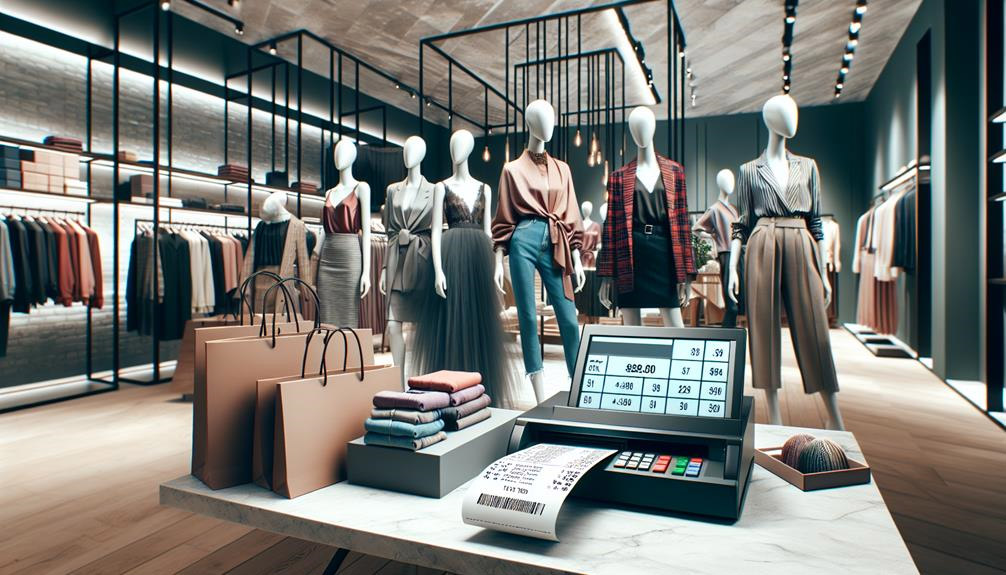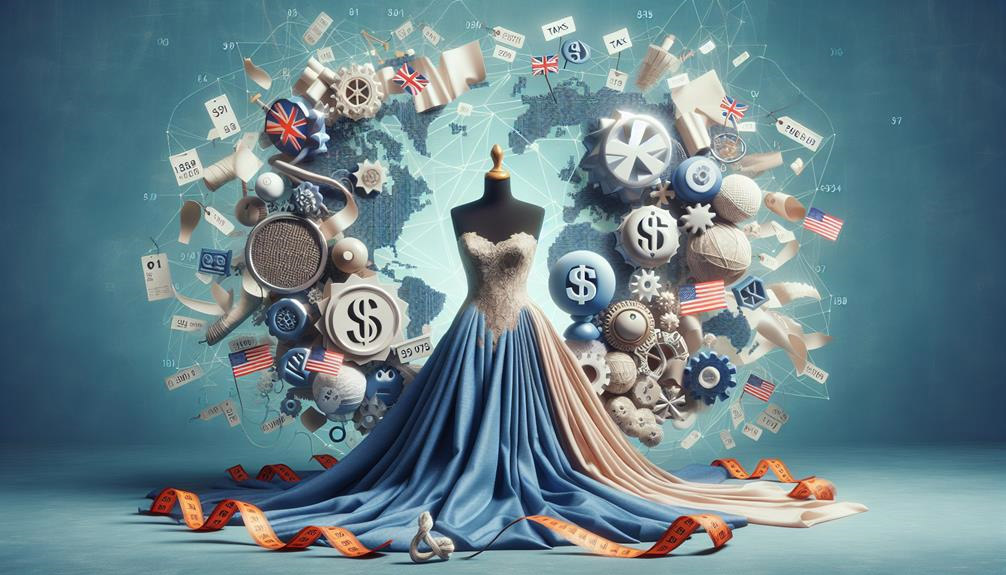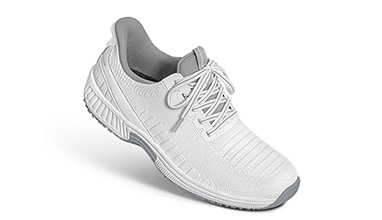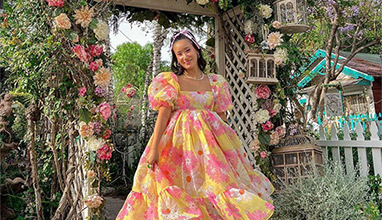The Price Tag of Style: Understanding Fashion-Related Taxes
When you shop for your favorite fashion items, have you ever wondered why some prices seem steep? It's not just the brand or quality; a significant part of the cost comes from various taxes. Import duties, VAT, and sales tax all play a role in inflating retail prices. Then there are excise taxes on luxury items and even environmental taxes aimed at promoting sustainability. By understanding these layers of taxation, you can make smarter purchase decisions and appreciate the complexity retailers face. So, what are the key taxes that affect your wallet when you're buying that stylish outfit?

Import Duties
When considering the impact of import duties on fashion, you'll find that these taxes considerably influence both the cost structure for retailers and the final price tags for consumers. Import duties, fundamentally tariffs imposed on goods entering a country, can range dramatically based on the apparel's origin and type. For instance, in the U.S., import duties on clothing can vary from 5% to 32%. This variability means retailers face unpredictable costs, which they often pass on to you, the consumer.
Analyzing the data, you'll see that importing a $100 garment from a country with a 20% duty results in an additional $20 cost. Retailers don't just absorb this; they mark it up. If their markup is 50%, that $20 duty transforms into a $30 increase in the retail price. So, your $100 garment now costs $130.
Moreover, high import duties can discourage retailers from sourcing quality materials or unique designs from specific regions, thereby limiting your fashion choices. Understanding these dynamics can help you appreciate why prices fluctuate and why some fashion items seem disproportionately expensive.
These import duties, while aimed at protecting domestic industries, ultimately shape your shopping experience and choices.
Value Added Tax (VAT)
Value Added Tax (VAT) considerably impacts the retail price of fashion items by adding a percentage-based tax at each stage of production and distribution. When you purchase a piece of clothing, you're not just paying for the fabric and labor. VAT is applied at every step—from the initial raw material procurement to the final retail sale. This tax can range considerably depending on the country, with rates typically between 5% and 27%. If you're interested in learning more about VAT implementation, check out this detailed article on implementing a VAT system in Saudi Arabia.
Let's break this down: if a designer purchases fabric for $100 and the VAT rate is 20%, they pay $120. When the garment is produced and sold to a retailer for $200, the VAT is again applied, making it $240. Finally, if the retailer sells it to you for $400, the final price including VAT is $480. Each stage increases the cost, which cumulatively inflates the retail price.
Understanding VAT's role in the fashion industry helps you see why luxury items often carry hefty price tags. Data shows that VAT contributes considerably to the final cost, sometimes accounting for as much as 30% of the retail price in high-tax regions.
This knowledge can guide your purchasing decisions, especially when shopping internationally.

Sales Tax
Unlike VAT, sales tax is only applied at the point of purchase and varies considerably across different regions, affecting the final price you pay at checkout. For example, if you buy a $100 dress in New York City, you'll pay an additional 8.875% in sales tax, making the final price $108.88. In contrast, buying the same dress in Oregon means you won't pay any sales tax, keeping your cost at $100.
Sales tax rates can fluctuate dramatically across states and even within cities. In California, the base state rate is 7.25%, but in certain cities, it can climb to over 10%. This variability means you need to be aware of local tax rates, especially when shopping online or while traveling. Online retailers often calculate sales tax based on your shipping address, which can lead to unexpected costs if you're not prepared.
Data from the Tax Foundation shows that the average combined state and local sales tax rate in the U.S. is about 7.12%. This figure underscores the importance of understanding regional tax policies, as they directly impact your purchasing power.
Being informed allows you to make smarter shopping decisions and better manage your fashion budget.
Excise Taxes
Excise taxes, often levied on specific goods like luxury fashion items, can greatly alter their final cost and are typically implemented to generate revenue or discourage certain consumption behaviors.
When you're purchasing high-end fashion, these hidden costs can greatly impact your budget. Excise taxes are particularly common on items perceived as non-essential or extravagant.
Understanding how excise taxes work in the fashion industry can give you deeper insights into your spending. For example, a luxury handbag priced at $5,000 might have an excise tax of 10%, adding an additional $500 to the final price.
This type of tax is often implemented for several reasons:
Revenue Generation: Governments use excise taxes as a reliable source of income, especially from high-spending consumers.
Behavioral Control: By making luxury items more expensive, these taxes can discourage excessive spending on non-essential goods.
Market Regulation: Excise taxes can help balance market dynamics by reducing the demand for high-end products, potentially benefiting local businesses.
Next time you're splurging on that designer dress, remember that excise taxes aren't just numbers; they reflect broader economic and social policies.
This awareness helps you make informed purchasing decisions and better understand the true cost of luxury.
Tariffs on Raw Materials
While excise taxes directly affect the final price of luxury fashion items, tariffs on raw materials like silk, leather, and cotton can indirectly drive up production costs, ultimately impacting consumer prices.
You may not think about the origins of your favorite designer handbag, but raw materials often travel across borders multiple times before reaching the production phase. With tariffs on imports, manufacturers face increased costs that they'll likely pass on to you, the consumer.
For instance, consider that the U.S. imposes a 10% tariff on imported silk from China. If a luxury brand sources high-quality silk for their garments, that additional cost inflates the base price. A study by the International Trade Administration noted that tariffs on raw materials could increase production costs by up to 15%. This ripple effect means you'll see higher price tags on finished products. Moreover, tariffs can cause manufacturers to seek alternative sources, sometimes compromising on quality. This could impact not only price but also the craftsmanship you've come to expect from premium brands.
Understanding these tariffs helps you grasp why your favorite fashion items might be more expensive than ever. It's a complex web of global economics that ultimately ties into your wardrobe.
Luxury Goods Tax
Luxury goods taxes, designed to target high-priced items, can greatly influence consumer behavior and market dynamics in the fashion industry. When you're considering purchasing an upscale handbag or designer suit, these taxes can alter your decision-making process. By increasing the final price, they aim to reduce the consumption of luxury items, potentially driving you to seek more affordable alternatives or reconsider the necessity of such purchases. From a market perspective, luxury goods taxes can:
Shift consumer demand: Higher prices may decrease demand for luxury items, affecting sales volumes for high-end brands.
Encourage brand diversification: Brands might introduce mid-range products to capture a broader audience and mitigate the impact of reduced luxury sales.
Impact resale markets: The higher initial cost of luxury goods can increase their resale value, making second-hand markets more attractive.
Data reveals that countries implementing luxury taxes often see a decline in domestic sales of high-end fashion, prompting brands to focus on international markets. As a fashion-conscious consumer, understanding these taxes helps you navigate the complexities of luxury purchases. Retailers, in turn, must adapt their strategies to maintain profitability while adhering to tax regulations.

Environmental Taxes
Environmental taxes in the fashion industry aim to reduce the sector's substantial ecological footprint by incentivizing sustainable practices and penalizing wasteful production methods. You might wonder how effective these taxes are in practice. According to a 2022 report by McKinsey, , fashion accounts for 10% of global carbon emissions. By imposing environmental taxes, governments can push brands to adopt eco-friendly technologies and materials.
Consider the example of France, where a tax on clothing waste encourages companies to recycle unsold items rather than dump them. In 2021, this resulted in a 10% reduction in textile waste. Similarly, Sweden's tax incentives for using recycled fibers have led to a 30% increase in their use across the industry.
You'll find that these taxes don't just serve as penalties; they also drive innovation. Brands like Patagonia and Stella McCartney have leveraged tax breaks for sustainable practices, resulting in less waste and lower carbon footprints. According to the Ellen MacArthur Foundation, if the fashion industry fully embraced circular economy principles, it could reduce emissions by up to 44%.
In essence, environmental taxes make it costly to ignore sustainability, nudging the fashion industry toward a greener future.
Digital Services Tax
How does the digital services tax impact the fashion industry's online sales and marketing strategies? The digital services tax (DST) fundamentally alters how fashion businesses navigate e-commerce and digital marketing. You're looking at additional costs that directly affect profit margins and pricing strategies. To remain competitive, fashion brands must adapt to these new financial pressures. For instance, the DST can influence your business in several ways:
Increased Advertising Costs: Platforms like Google and Facebook may pass on the tax to advertisers, making digital marketing campaigns more expensive.
Higher Product Prices: To offset the tax burden, you may need to increase product prices, potentially affecting consumer demand.
Strategic Realignment: Companies might shift marketing budgets towards less-taxed regions or invest in organic growth strategies, impacting overall marketing effectiveness.
Data from the European Union suggests that businesses have faced up to a 5% increase in operational costs due to the DST. Consequently, you'll need to carefully analyze your pricing models and marketing expenditures.
Understanding these dynamics helps you anticipate market shifts and make informed decisions to maintain profitability and competitive edge in the digital marketplace.
Counterfeit Goods Penalties
As you navigate the complexities of digital taxation, it's equally essential to understand the severe penalties associated with counterfeit goods that can drastically impact your brand's reputation and financial health. Counterfeit goods are a pervasive issue, costing the fashion industry approximately $450 billion annually, according to the Global Brand Counterfeiting Report. Engaging in counterfeit activities, even unintentionally, can lead to significant fines and legal repercussions.
For instance, the U.S. Customs and Border Protection (CBP) has the authority to seize counterfeit products, and penalties can range from hefty fines to criminal charges. In 2021 alone, the CBP seized over $3.3 billion worth of counterfeit goods. Besides financial penalties, your brand could face lawsuits from intellectual property holders, resulting in massive legal fees and settlements.
Moreover, counterfeit goods can erode consumer trust. A study by the International Trademark Association found that 70% of consumers would lose trust in a brand after purchasing a counterfeit product. This loss of trust can translate to decreased sales and long-term damage to your brand's integrity.
Understanding these penalties and their implications can help you take proactive measures to safeguard your brand against counterfeit risks, ensuring sustained growth and consumer loyalty.
Customs Brokerage Fees
Steering through customs brokerage fees is crucial for managing the cost-efficiency of your international fashion supply chain. These fees, paid to customs brokers who facilitate the import and export of goods, can greatly impact your bottom line if not carefully managed. Analyzing these costs and their implications allows you to make informed decisions that enhance your financial efficiency.
Customs brokers provide essential services, including:
Completing Documentation: Ensuring all required paperwork is accurately filled out and submitted, reducing the risk of costly delays.
Classifying Goods: Correctly categorizing your products to determine applicable duties and taxes, which can prevent overpayment.
Facilitating Communication: Acting as intermediaries between you and customs officials, helping to resolve any issues that arise promptly.
Regional Tax Variations
Understanding regional tax variations is key to optimizing your international fashion supply chain, as differing tax rates and regulations can considerably influence overall costs and profitability. For example, in the European Union, the Value Added Tax (VAT) can range from 17% in Luxembourg to 27% in Hungary. Such disparities affect your pricing strategy and profit margins.
You should also consider import duties, which vary not just by region but also by product type. For instance, the United States imposes a 16% duty on women's blouses from China, but only 8% for similar items from India. This differential can guide your sourcing decisions to more tax-efficient regions, enhancing your cost-effectiveness. Moreover, some countries offer tax incentives for fashion brands. Italy, for instance, provides tax credits for companies investing in sustainable fashion, while Singapore offers rebates for businesses that establish regional headquarters. These incentives can considerably reduce your tax burden. To stay competitive, leverage data analytics to monitor and respond to these regional tax variations. By doing so, you'll make informed decisions that optimize your supply chain and boost your profitability.
Tax-Free Shopping
Tax-free shopping presents a valuable opportunity to increase consumer spending by allowing shoppers to reclaim the Value Added Tax (VAT) on eligible purchases. When you take advantage of these schemes, you effectively reduce the overall cost of luxury items and high-end fashion, making them more affordable. This practice can be particularly appealing for international travelers who are often eligible for tax refunds on purchases made abroad. By understanding the benefits of tax-free shopping, you can make more informed purchasing decisions. Key advantages include:
Cost Savings: By reclaiming VAT, you can save up to 20%, depending on the country's tax rate, considerably lowering the price of your fashion purchases.
Increased Spending Power: These savings can translate into increased purchasing power, allowing you to buy more items or higher quality goods.
Boost to Local Economies: Increased spending by tourists can drive growth in local retail sectors, providing a boost to the economy.
Data from the Global Blue and Premier Tax Free services show that countries offering tax-free shopping, such as France and Italy, have seen a marked increase in tourist spending. This practice not only benefits consumers but also supports local businesses and economies.
Tax Implications for Online Shopping
Steering through the tax implications for online shopping requires a keen understanding of varying tax regulations across jurisdictions, which can greatly impact the final cost of your purchases. In the U.S., for example, each state sets its own sales tax rate, and some states don't have sales tax at all. This means a purchase from an online retailer based in Delaware, which has no sales tax, could be cheaper than one from California, where the combined state and local sales tax can exceed 10%. When you're shopping internationally, value-added tax (VAT) or goods and services tax (GST) may apply, depending on the country. The European Union, for instance, applies a standard VAT rate that can range from 17% to 27%, depending on the member state. These taxes are often included in the listed price but can still notably increase the total cost. Additionally, import duties may apply for cross-border transactions. The duty rates vary based on the product category and the trade agreements between countries. For instance, importing clothing into the U.S. from non-FTA countries can incur duties up to 32%. Understanding these complexities can help you make more informed purchasing decisions.
Strategies to Minimize Tax Costs
Steering through these tax complexities can be challenging, but employing effective strategies can help you minimize tax costs and optimize your fashion-related expenditures. To start, understanding the specific tax laws in your location is essential. By familiarizing yourself with these regulations, you can identify opportunities for tax deductions and credits that could greatly reduce your overall tax burden. Here are three strategies to take into account:
Shop Tax-Free Holidays: Many regions offer tax-free holidays on clothing and footwear. Timing your purchases to coincide with these periods can result in substantial savings.
Leverage Business Expenses: If you're in the fashion industry, such as a designer or influencer, many of your clothing purchases may qualify as business expenses. Keeping detailed records allows you to claim these deductions accurately.
Utilize Online Retailers: Some online retailers don't charge sales tax depending on your location. Researching and purchasing from these platforms can help you avoid additional costs.
Steering through fashion-related taxes is like threading a needle through a complex maze. By understanding import duties, VAT, sales tax, and other financial hurdles, you can make smarter purchasing choices. Retailers can also strategize to minimize tax costs and stay competitive.
Data shows that being informed can save you money and make stylish garments more accessible. So, next time you shop, remember that knowledge is your best accessory.
Hits: 4418 | Leave a comment

















